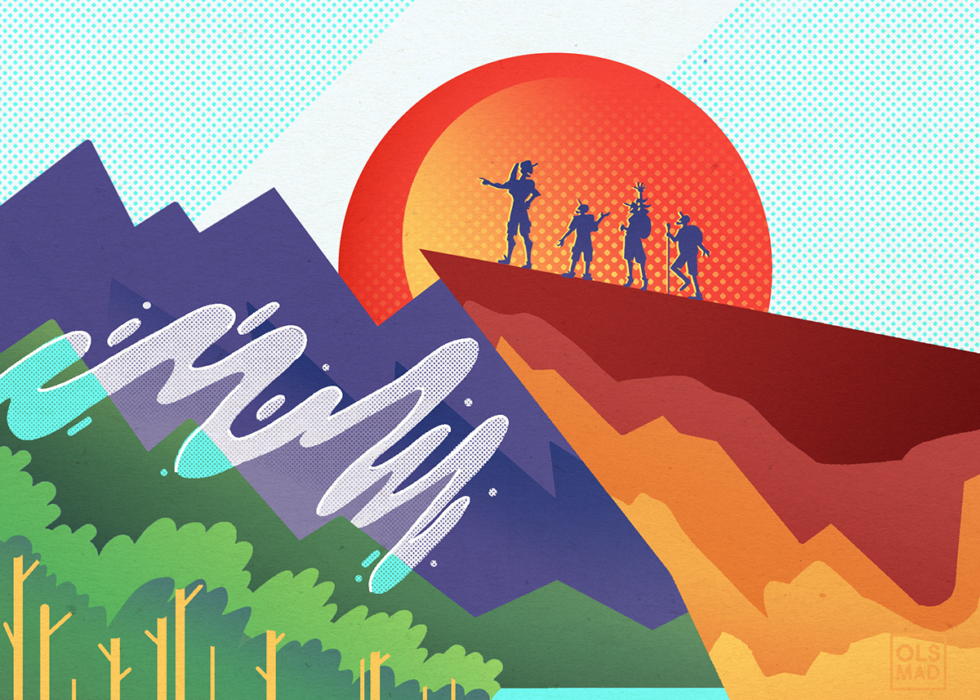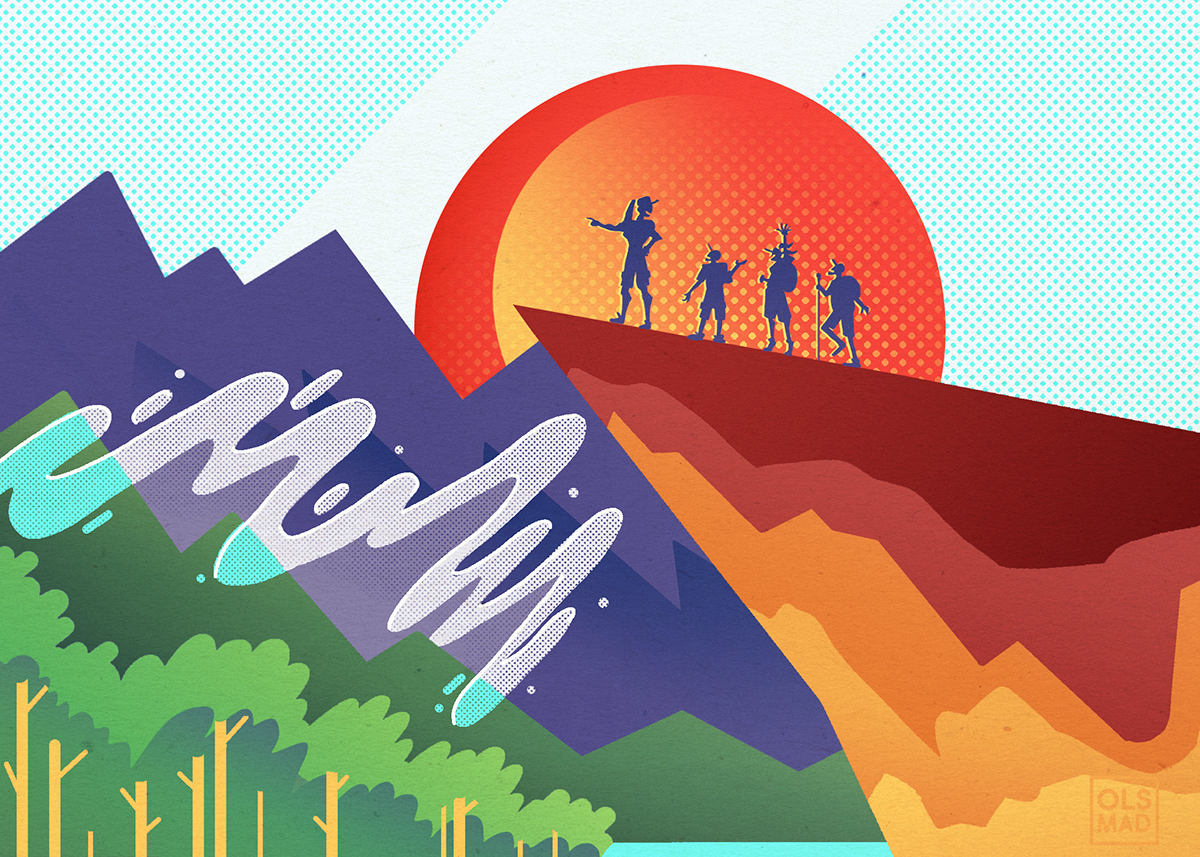
Some 2,300 years ago, in a garden classroom outside Athens, a teacher offered up an unconventional lesson plan: happiness.
Abundance, Epicurus once said, is constituted by “not what we have, but what we enjoy.” To attain that lasting joy, the now-famed Greek philosopher taught students three practices: to adopt ataraxia (freedom from distraction), to resist kenodoxia (empty desires), and to embrace two limitless sources of pleasure: friends and nature.
When Luis Perez was 11, he didn’t have much access to either. He had just migrated to San Diego from Aguascalientes, Mexico, and struggles with language and social discomfort initially kept him from spending much time outside. But when a representative came to his high school and introduced Outdoor Outreach — a California nonprofit providing young people from low-income communities with free access to nature adventures — he had found his ticket to more confidence and better mental health.
“Back then, I was this 100-pound skinny kid who couldn’t communicate very well,” Perez, now 25, remembered. “But through the program, I saw snow for the first time, I caught my first wave — I was able to see the power of nature, and it felt … natural.”
Today, a growing body of scientific evidence supports the ancient wisdom of Epicurus and the truth Perez found with Outdoor Outreach. According to a review of 68 experimental and longitudinal studies, there exists “solid evidence that exposure to green space in urban areas can reduce stress, improve mood, and prevent premature mortality,” Michelle Kondo, a U.S. Forest Service scientist and the review’s co-author, said.
For Westerners, there’s a somber need to take note. Eight of ten states with the highest suicide rates are in the American West, and for people ages 10 to 34, suicide ranks as the second-leading cause of death, according to the National Institute of Mental Health. Teenage depression is also common to the region; of the five states with the highest percentage of youth experiencing a “major depressive episode,” four are in the West.
Kondo said the rise of mental health issues among children and teens has scientists curious about nature’s role to mitigate them. And although “permission difficulties” and design limitations make large-scale research difficult, small observational studies show promise. Researchers in Colorado found green schoolyards help children reduce stress, and another study by the Barcelona Institute for Global Health suggests living near green space enhances kids’ cognitive development. More recently, a longitudinal study that followed nearly 1 million Danish people found that living near greenery in childhood is associated with a lower risk of numerous psychiatric disorders in adulthood, even when adjustments are made for externalities like socioeconomic status.
That evidence was enough for Dr. Kyle Yasuda, president of the American Academy of Pediatrics, to declare “connecting children and families with nature” one of the AAP’s four priorities for 2019. Yet in doing so, Yasuda also acknowledged a barrier: unequal access to nature, since some children and teens, “especially in low-income areas,” may lack green spaces where they can play safely and easily.
Despite Western cities’ reputations for mountains and vistas, children in our region see this barrier firsthand. According to The Seattle Times, fewer than one in five kids in King County gets outside for the recommended one hour of physical activity per day. For less affluent communities, barriers like implicit bias on sports teams and an inability to access green space stand in the way. A report from The Urban Institute adds how the work commitments of teens in low-income families might also prevent them from enjoying the great outdoors.
Congress has removed a barrier to accessing national parks for some. Originally introduced in 2015, the Every Kid Outdoors Act provides free national park passes to fourth graders and their families. Though former Interior Secretary Ryan Zinke repeatedly threatened to cancel the program, which served more than two million students from Title I schools in its first two years, Congress renewed its funding this February for seven more years.
“Its passage is a really strong testament to the bipartisan nature of getting kids outdoors,” said Jackie Ostfeld, chair of the Outdoor Alliance for Kids, an advocacy group that pushed for the bill.
Ostfeld emphasized how children themselves — who flooded Congress with more than 1,000 postcards praising the bill — were the initiative’s strongest supporters. As a former outdoor educator herself, she understands why.
“Kids go from being scared, confused, and then the lightbulb goes on — not just for the science aspect, but the social aspect, too,” Ostfeld said. She remembered expeditions where kids worked together who normally wouldn’t socialize at school.
According to Dr. Mark Tremblay, professor of pediatrics at the University of Ottawa, there’s empirical substance behind observations like Ostfeld’s. After consulting nearly 2,000 stakeholders, Tremblay spearheaded an evidence-based position statement on the positive relationship between play in nature and healthy youth development. But the top-line takeaway of that research, Tremblay said, is not only that “outside is good,” but also that “inside is bad.”
“Humans and other species were meant to be outdoors,” he explained, adding that the rise of obesity, myopia, and vitamin D deficiencies all have roots in more time spent indoors. “And in earlier generations, being outside was the default.”
Screen time is a major issue for youth — not only because young people could otherwise spend that time outside, but also because staring at phones, computers, and TVs bears its own mental health consequences. A Preventative Medicine Reports analysis of more than 40,000 children and adolescents found those who spent seven or more daily hours on screens were twice as likely to be diagnosed with depression and anxiety than those who spent just one hour before screens.
A 2015 survey by Common Sense Media, a research organization focused on youth media use, found that low-income teenagers who use smartphones spend more than twice the amount of time on them than do their higher-income peers.
That’s one more reason programs like Outdoor Outreach can have such an impact today. In the organization’s 20-year existence, it has brought nearly 14,000 youth — the vast majority of whom are Latinx — to nature that previously seemed inaccessible.
To achieve that scale, Outdoor Outreach relies on a hefty volunteer network, donations and dedicated staff like Perez, who until recently coordinated the nonprofit’s leadership program. “Whenever I’m on an outing with the teens and I’m able to see the huge grin on their face after they complete a hard route,” he said, “it makes me realize that this is where I’m supposed to be and what I’m supposed to be doing.”
Perez knows well the lasting benefits of an outdoor experience. “I remember my first time rappelling. We were near my house, but I was so far out of my comfort zone.”
Like a modern Epicurus, Perez now sees the bigger picture. Confronting his nerves on that rock face established a broader sense of resilience he can utilize in other scenarios.
“Whenever I feel that same lack of comfort, I know I can always take on the challenge,” he said. “Being scared allowed me to eventually become comfortable with uncertainty.”

